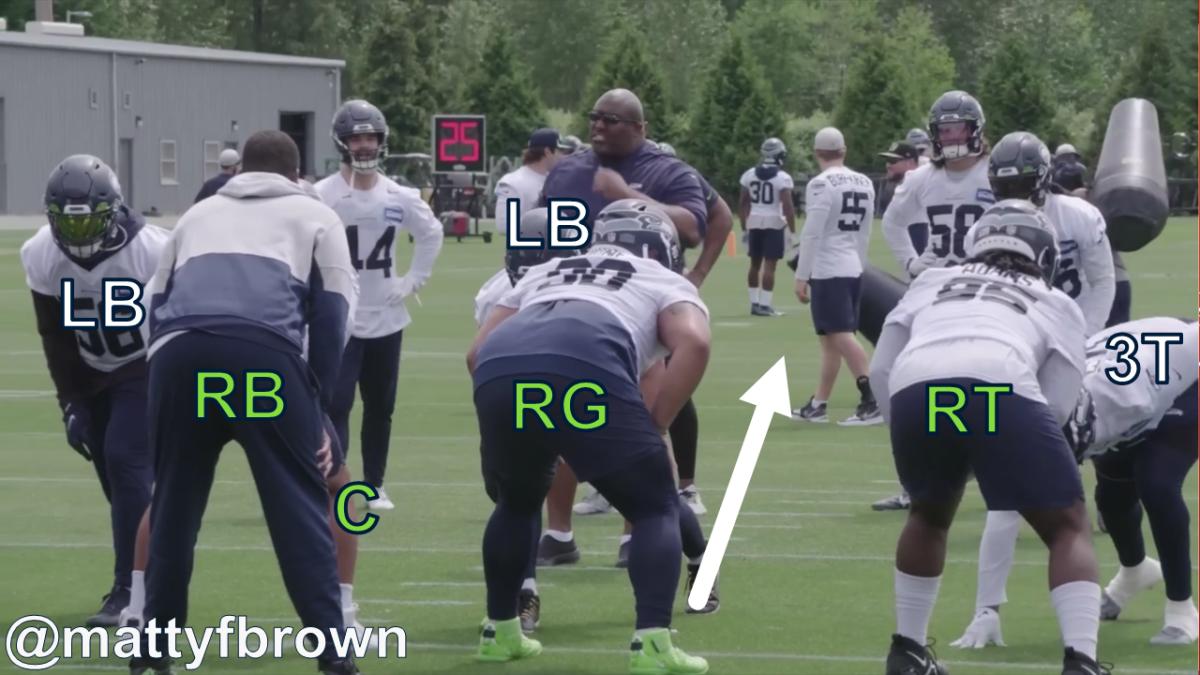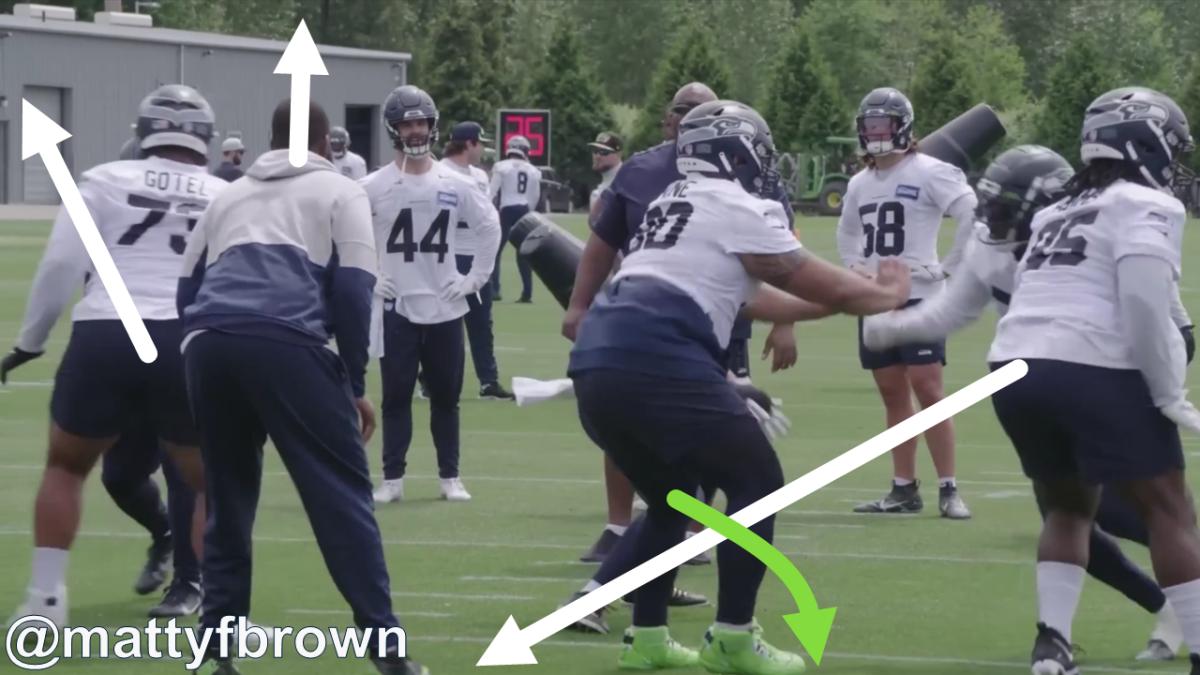Seahawks Schematic Detective: ‘Backer Fire Zones and 1 Hug Games
The “Sound of the Seahawks” series continued this week, with episode two of the official Seahawks YouTube production taking a look at Seattle’s defensive side of the football. There was the obviously cool behind-the-scenes access, but beyond that we also got opportunities to delve deeper into the footage and - once more - play schematic degenerate detective. Consider this an explainer of the football jargon and why it matters.
“When we get to individual today, alright Indy today, we’re gonna go through all of our ‘backer fire zones or ‘backer 1 hug games,” defensive coordinator Clint Hurtt said, going through the practice plan with his defense. “Okay so you guys will start off Indy with your coaches, OLBs, ILBs, alright, d-line, and then I’ll yell for you guys, we’ll all come together and we’re gonna have our game review and walk through all of our stuff.”
That was Hurtt essentially getting the front seven defenders together for an install of fire zone and 1 hug games. So what does this mean?
Well, a “fire zone” is a pressure concept where five defenders - rather than the usual four - rush the quarterback. With the defense losing a coverage defender while gaining a rusher, they must play with tighter coverage principles on the back end. Be it in three-deep, three-underneath (a Cover 3 fire zone) or two-deep, four-underneath (a Cover 2 fire zone), the Seahawks run both although - like most of the league - lean towards three-deep, three-under concepts.
The first play in this video is Cody Barton in the 2021 preseason blitzing on a three-deep, three-under fire zone with the Seahawks in their bear front. Seattle’s line slants to create room for Barton’s pressure. The blitz-side 3-technique going into the A-Gap causes the guard and tackle to step down. Barton keys pass and key blitzes into the opening the tackle stepping down left (he would have had B-Gap responsibility in a run fit situation).
Cody Barton's 2 sacks deserve more credit.
— Under Zone X (Frisco)/Phoenix Check/Stick Slasher2 (@mattyfbrown) August 17, 2021
#1: MLB 3d, 3u FZ out of the #Seahawks' "stick" 🐻 front. Barton waits for 3t to clear, gets pass read + then beats RT Jaryd Jones-Smith
#2: Nickel even mugged front, Barton adds on 🔥 as hug rusher in 1 robberpic.twitter.com/jqhIk6vWuy
“1 Hug” refers to a five-man pressure with Cover 1 pass defense behind it: man-to-man with a post defender closing the middle of the field. The hug element in the Seahawks’ defense refers to what would normally be a second-level defender, typically a linebacker, hug-rushing the running back. This is often done from a down-at-the-line-of-scrimmage position. If the back releases on a pass route, the linebacker will cancel his pass rush and cover the back. However, with the way this pressure works, the usual result is that the linebacker hug rush keeps the running back in pass protection.
The second play in this video is Barton in the 2021 preseason blitzing on a 1 hug pressure with the Seahawks in a nickel even front. Seattle plays Cover 1 robber pass defense and Barton - mugging the center in between the two 3-techniques - is the hug rusher. It is a somewhat funky example of hug, yet we know it is the hug concept because Barton told the broadcast team in a sideline interview.
#Seahawks LB Cody Barton told the Seattle broadcast that his second sack came via a "hug rush" - similar to a green dog blitz
— Under Zone X (Frisco)/Phoenix Check/Stick Slasher2 (@mattyfbrown) August 15, 2021
(Note that the difference with a green dog is the linebacker aligning off the ball and adding on to the pressure once he has cleared his coverage responsibility)
Barton’s running back went across the formation in pass protection - an unexpected look for the linebacker given Seattle’s pre-snap appearance. Barton therefore thought the back was releasing on a route and - after his first downhill step - cancelled his blitz, flaring out to cover the back man-to-man into the flat. It looked like a slip screen concept. Once Barton realized the back was only going across the formation to pass protect, the linebacker relaunched his blitz and brought down the quarterback.
Cody Barton's 2 sacks deserve more credit.
— Under Zone X (Frisco)/Phoenix Check/Stick Slasher2 (@mattyfbrown) August 17, 2021
#1: MLB 3d, 3u FZ out of the #Seahawks' "stick" 🐻 front. Barton waits for 3t to clear, gets pass read + then beats RT Jaryd Jones-Smith
#2: Nickel even mugged front, Barton adds on 🔥 as hug rusher in 1 robberpic.twitter.com/jqhIk6vWuy
The ”games” part of Hurtt’s message refers to the movements that the five pass rushers execute up front. These are coordinated movements designed to stress an offensive line’s communication and - most of the time - beat the one-on-one side of pass protection.
In the case of Seattle’s 3-4 bear fronts, they will face one-on-ones across the five guys down at the line of scrimmage. A simple way of beating this man coverage is to run a three-man game with the interior trio of defensive linemen. Two of the DL can pick in one direction, creating a pick or rub for the third DL looping tight into the vacated space.
We actually saw part of this install in the episode - and also in Hurtt’s mic’d up appearance. The Seahawks were in an even, two 3-technique front, with inside linebackers Cody Barton and Jordyn Brooks mugging the line of scrimmage to close the open A-Gaps.
Based on the way Barton and Brooks behaved, Seattle’s defense is acting as though they have identified the center’s “mike” point - where the pass protection is sliding to - pre-snap. Brooks did not have the body language of anyone other than a useful drill dummy and no game is run to his side. Working out which side the offense has identified as the mike linebacker is a major part of the Seahawks’ game-planning and pass rush execution on the day. That’s because it tells them where the one-on-ones are - and therefore which side they should be running games to.

Indeed, the ‘center’ Matt Gotel slid towards Brooks’ side. The one-on-ones were therefore to Barton. Seattle used an assistant coach as a running back in the “sniffer” position, a common response from offenses - including the Seahawks - to this double mugged, double 3-tech look. The game the Seahawks used to beat the protection was clever.
First, blitz-side 3-technique Quinton Jefferson took two upfield steps before crashing hard into the A-Gap. This is attempting to occupy the guard’s attention, then selling an inside pass rush move to the guard. This is all done to prevent quick recognition of the game and an easy pass off. You can see Jefferson at the end of the play looked to obstruct the sniffer too.
Barton executed what is almost a linebacker version of a “coffee house” stunt with some fake spin vibes too. The LB stepped back as though he was dropping into pass coverage. This synced up with the timing of Jefferson’s inside movement, giving it time to clear. It also meant that the sniffer running back diverted his attention to the next rushing threat. That is crucial, as the back is the man responsible for picking up the blitzing Barton. Then, with Jefferson picking and causing the guard to step down, Barton ripped through the widened B-Gap on his blitz with the running back unaware.

Darrell Taylor off the edge provided the edge rush spacing.
— Ultra Rare Tape (@UltraRareTape) July 1, 2022
Shortly after earning the defensive coordinator gig, Clint Hurtt stated that he wanted his unit to be more aggressive as a defense. A big part of whether Hurtt is successful in this goal for the Seahawks is the ‘backer fire zone and 1 hug pressures, plus games, popping.
